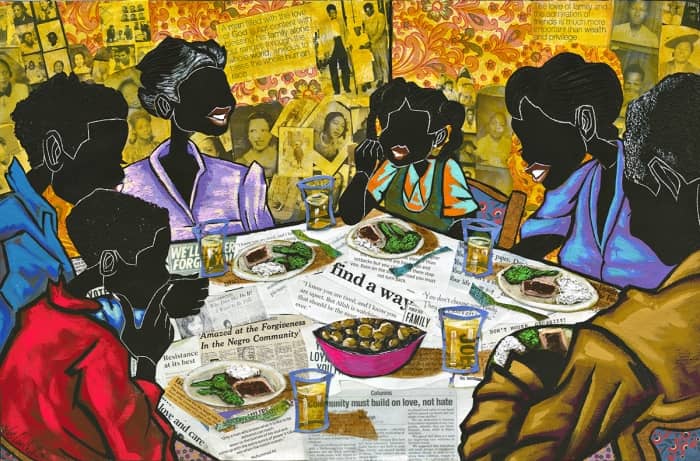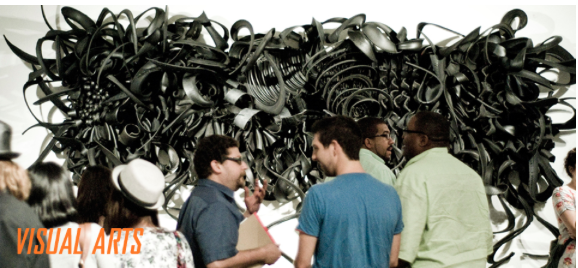Above: Well Feed by Leroy Campbell.
Atlanta-based painter, Leroy Campbell’s most recent solo exhibition, is a call to action and an appeal for global community building. “Working Together,” which opened last month at Richard Beavers Gallery, features many new works that reflect the historical importance and contemporary relevance of the collective.
I spoke with him a few days before his opening about his creative practice and his journey to find and build a thriving Black community.
_
Martina Dodd (MD): Can you tell me a little bit about your upcoming exhibit, “Working Together?” What was the inspiration behind the title?
Leroy Campbell (LC): It is an ongoing body of work, but I am introducing over 12 pieces from a new series, I call “Working Together.” It’s thematic in that it focuses on the family perspective, economics and how that could be used as tools to better help Black people take care of themselves and help build their community. So I use elements like newspaper clippings to show historical documentation of past thriving Black communities, and things we’ve accomplished, after reconstruction and other periods to help promote that idea. Like I may show a couple of Black farmers, Black grocery stores, and people just working together. Using a mixed medium of collage on canvas to indicate when the community brings their strength together they can do much more to help take care of ourselves, especially in times like these. So the show is to stimulate the conversation and a call to action, but it’s also in response to many people who I’ve been hearing saying art is a conduit for solutions and ideas.
MD: It sounds like within this exhibit and in many of the previous works that the interconnectedness of a community is fundamental to you. How do you define Community?
LC: I grew up in a community where we lived in the same area, we had our own businesses and stores that we could frequent. We had our community where we all could interact with each other. The generations stayed connected. We lived where the dollar-our dollar-gets to circulate ten times in our community. Where the individual strengths tributes to the communal whole. Now, you know communities are fragmented. So we have to walk with the community spirit within us. We have to look to find Black physicians to support and help them grow. Help them thrive, seek to help each other be better. We have to learn how to speak to each other kindly and learn to take a lesson from our history and apply them to now and never give them up because they’re very valuable to even the present day. So that’s my idea of a community.
That’s the kind of message I want to show in the art. We don’t have an all-Black community like Chinatown; you can go to Little Italy in New York and find a community where all those people are. I think the idea is that one day we will get back to creating that community because we need it. But in the meantime, we can walk with the community sensibility in us. We know about our history. We know what’s happening to us. We know what our statistic looks like in terms of economics, health, education, and politics. I think we could begin to pull our work back to creating our neighborhood because we need an area like that, so people can see each other and learn from each other. Because children learn from what they see, so we still need to have that. But in the meantime, we need to again create that sense of community just by coming out, looking for each other, supporting each other and not fighting against each other.
MD: Do you feel that social media has or can be a space to create a Black community that may not be apparent in our physical neighborhoods?
LC: Yeah, I think social media can play a role, matter of fact social media is in some way one of those vehicles that are getting the word out about the need for us to work and come together. It’s just along with social media those who use it need to be deliberate about staying connected and supporting each other. Social media does have a lot of wretchedness and has a lot of negative as well. That’s the problem with social media. But one thing I like about social media is that you can find like-minded people in a global way. You can find people who think alike all over the world. Now that’s powerful. Now we need to take that power and turn that to something tangible so that we can support each other and build.
MD: Do you see your art as a way of documenting the lived and shared experiences of African Americans?
LC: Yes, when I incorporate the concept of interactions between us and use historical newspaper articles that are cohesive to that message. I’m using not only the visual but I’m also documenting the actual history, right? So when people view the work, they not only see the concept, but they can read and envision it. I’m giving you actual references for this happening previously.
MD: How do you source your newspaper clippings and images that you incorporate in your collages?
LC: I’ve been blessed in a variety of ways. There are a few Black-owned bookstores and Black businesses that have old newspapers, and they will call and give them to me. I’ll go online. I’ve reached out to universities. Sometimes, families-you’d be surprised how many families and people have kept clipping articles that they want me to have. It’s just been a blessing. There are several bookstores in Chamblee, Atlanta that allow me to go in their basements and there’s a lot of old clipping articles referencing us, but it’s labor-intensive work.
MD: It sounds like within this process of collecting images and newspapers that you are acting as an archivist and researcher.
LC: I never thought about it until now, but I am a researcher, I am an intense researcher. The creative process I have now includes researching and archiving information as a part of my artistic practice. It’s all of it. So yes, right now I’m in deep research. I have a lot of information that I’ll come across, and I’ll say oh I’m going to use this later. This is information that needs to be put out. This is a very innovative way to present history, how beautiful, how powerful it is to have history in full view. Every time they look at the art they are looking at the concept, and they’re reading history. They are getting literature and history, how powerful is that! So it makes me an activist, it gives me a sense of empowerment to know this information that was thought never to be seen again will not take away from the art. You cannot remove it from the painting. I know that there is a lot of power, there is a lot of affirmation, a lot of call to action when we study our history. There is a lot to learn that we need now.
MD: What lessons do you hope people that come to your exhibit will learn or gain from seeing your work?
LC: When it comes to the exhibition I hope that they will walk away with the lessons of being deliberate about being black, unapologetically; and be intentional about working together. Only focusing on our strengths and what we can do to get things done and that’s it – not fighting over ideologies or labels. We don’t have to be uniform, but we need to be deliberate about doing and being active. We’re not going to talk about what we don’t do or what’s wrong with us. We’re just going to talk about what we do; we are talking about our strength. This exhibition is about our power, the strength we bring individually and as a group to help us build and work together to make make a better community for ourselves and our children.
Working Together is currently on view at Richard Beavers Gallery until January 5, 2019.










